Growth is often determined by protein intake
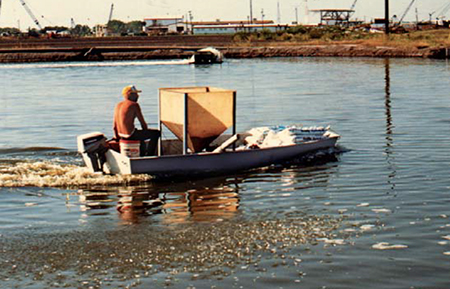
Protein is one of the most costly components of shrimp feeds, and formulating a diet that meets the protein (amino acids) requirement of shrimp is critical, because it is one of the major limiting nutrients for growth. To control costs, it is desirable to minimize the protein percentage in feed, but reductions should not compromise shrimp performance. To understand the influence of dietary protein on growth rate and final harvest weight, one must also consider the effect of feed intake.
Proper management
Proper feed management is as important as feed formulation in promoting adequate shrimp growth while reducing waste and pollution. To avoid poor feed conversion and water quality problems, farmers must match feed and nutrient inputs with growth throughout the production cycle.
Optimizing nutrient and energy intake
Some of the disagreement regarding protein levels in feed results from a misunderstanding of how to optimize feed management practices while meeting protein requirements. Growth is the result of a daily intake of energy and nutrients such as protein. Daily protein intake is directly related to the protein concentration in the feed and to the total amount of feed consumed.
Poultry industry
The poultry industry has developed into a profitable venture despite very small profit margins. It is successful because it understands the importance of feed intake and nutrient content of diets. Most egg-laying hens receive a feeding program based on changing the nutrient density of the diet as feed intake and egg production changes.
Knowing feed consumption
Proper use of this feeding program requires knowledge of the flock’s feed consumption at every age during the production period. As feed intake changes, nutrient content in the diet is adjusted accordingly, ensuring proper intake of nutrients required to maintain desired production.
By adjusting protein levels of the feed to match intake, overconsumption of protein is avoided, resulting in cost savings and reduced nitrogen excretion. By using this feeding program in association with essential amino acid supplementation in diets, the layer industry has reduced daily protein consumption by as much as 20 percent.
Implications for shrimp farmers
If farmers match the protein requirement of their shrimp with the amount of feed allocated at any time during the growing season, considerable cost savings are possible. But to realize such savings, one must understand the relationship between dietary protein concentration and feed intake.
Studies with Litopenaeus vannamei
To evaluate the influence of dietary protein and feed intake, eight experiments were conducted at the University of Texas’ Marine Science Institute, Fisheries and Mariculture Laboratory, in Austin, Texas, USA. The tests used juvenile, 1.5-gram and sub-adult, 7-gram shrimp grown under controlled laboratory conditions in the absence of natural foods, to estimate the protein requirements for maximum growth and compare responses to various levels of dietary protein.
Protein delivery and E:P ratios
To achieve the various delivery rates of protein to shrimp, daily rations were adjusted based on the targeted protein delivery and protein content of the diet. Test diets were formulated to contain 16, 32 and 48 percent crude protein, with energy:protein ratios of 25.1, 12.6 and 8.9 kilocalories per gram protein, respectively. Results indicated that protein requirements for juveniles were 43 to 46 grams of dietary protein per kilogram body weight per day, with 20 to 24 grams of protein per kilogram body weight per day required for sub-adult shrimp.
Test diets and feeding levels
In all experiments, shrimp offered the 16 percent-protein diet were unable to consume enough protein to attain final weights equivalent to that of shrimp maintained on the higher-protein diets. For example, juvenile shrimp (1.7 grams initial weight) were offered 42 grams of protein per kilograms body weight per day over a four-week period. Using the 16 percent-protein diet, the shrimp were fed at a rate of 26 percent of their body weight, whereas using the 32 percent-protein diet, the shrimp were fed at a rate of 13 percent of their weight. Because the 32 percent-protein diet contains twice the protein of the 16 percent diet, feed inputs were halved to deliver the same amount of protein.
Weight gain and feed efficiencies
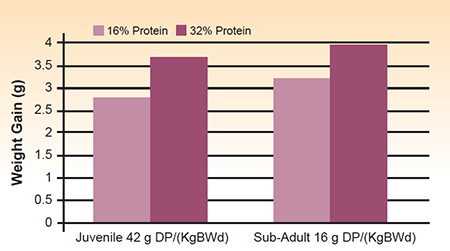
Figs. 1 and 2 show the weight gain and feed efficiencies (FE = gain x 100 per feed offered) of the juvenile shrimp, and include an example of sub-adult shrimp that were offered the same two feeds at 16 grams of protein per kilograms body weight per day over a four-week period. Growth of shrimp offered the 16 percent-protein diet was less and feed efficiency was approximately half that of shrimp offered the 32 percent-protein diet.
Although differences in feed efficiency would be expected due to the differences in dietary nutrient density, the poor growth was probably due to several factors. These include high levels of carbohydrates in the diet that reduced protein digestibility, and increased energy expenditures associated with consuming twice the volume of feed in an attempt to meet the shrimp’s protein requirements.
Weight gain of the juvenile shrimp fed the 32 percent-protein diet was significantly greater than for shrimp fed the 48 percent-protein diet. The likely reason is that the low energy:protein ratio in the 48 percent protein diet meant the shrimp would have less protein (amino acids) available for growth, since a larger portion of the protein was probably used for energy.
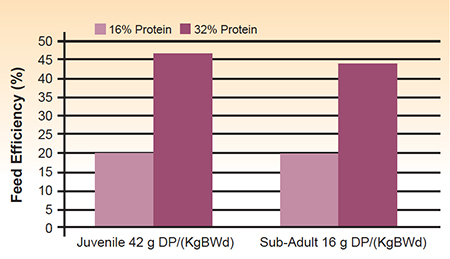
Although growth was less on an iso-nitrogenous intake basis, feed efficiency was improved because of the increase in the nutrient density of the diet. Shrimp fed the 16 percent-protein diet never reached the growth achieved by shrimp fed the two high-protein diets, even though the availability of feed was not limited. Hence, the choice between using a 32 percent and 48 percent protein diet would be based on the overall cost effectiveness.
Disadvantages of excess protein
Feeding a diet too high in protein can also have disadvantages, primarily because it is more difficult to maintain proper energy:protein levels. In a separate experiment, 1.3-gram juvenile shrimp were offered 41 grams of protein per kilograms body weight per day. Shrimp offered the 32 percent protein diet, fed at a rate of 12 percent of their body weight, grew 3.4 grams with a feed efficiency of 51.7 percent. Shrimp offered the 48 percent protein diet, fed at 8 percent of their weight, grew 2.9 grams with a feed efficiency of 68.7 percent.
Commercial implications
The results of these studies have important implications for the commercial shrimp-farming industry. On farms with good feed management, simply changing to a diet containing less protein will result in reduced feed conversion efficiencies, increased organic loading of the system, and possibly reduced growth if the protein requirement cannot be met through increased feed intake.
On the other hand, increasing the concentration of protein in the diet to excessive levels will not necessarily result in increased production, because energy will be more limiting than protein. However, if a properly formulated feed is utilized, and the farmer adjusts feed inputs based on the desired protein intake, protein retention by shrimp will be similar.
In situations where overfeeding occurs, reducing the protein content of the feed quite often does not influence production, and is hence considered economical. This occurs because an excess of feed protein is already being offered, but not necessarily eaten. In this case, simply reducing feed inputs would produce a similar response.
Conclusion
Farmers often reach conclusions regarding feed protein levels based on improper comparisons. In properly formulated feeds, protein is the most costly component, and hence its retention by shrimp should be maximized. Additionally, growth is often determined by protein intake.
In situations where overfeeding occurs, reducing the protein content of the feed quite often does not influence production, and is hence considered economical. This occurs because an excess of feed protein is already being offered, but not necessarily eaten. In this case, simply reducing feed inputs would produce a similar response.
If feeding rates are properly managed, the appropriate evaluation of feeds with different protein levels would be as follows. If a 30 percent-protein diet is being used and the benefits of a higher-protein feed are to be evaluated, the quantity of the high-protein feed should be reduced to deliver the same quantity of protein. To compare 30 percent- and 40 percent-protein diets, the low-protein diet would be offered at 100 percent and the high-protein diet fed at 75 percent (30/40 × 100) of the full ration (i.e., quantity of the 30 percent-protein diet).
(Editor’s Note: This article was originally published in the April 2001 print edition of the Global Aquaculture Advocate.)
Now that you've reached the end of the article ...
… please consider supporting GSA’s mission to advance responsible seafood practices through education, advocacy and third-party assurances. The Advocate aims to document the evolution of responsible seafood practices and share the expansive knowledge of our vast network of contributors.
By becoming a Global Seafood Alliance member, you’re ensuring that all of the pre-competitive work we do through member benefits, resources and events can continue. Individual membership costs just $50 a year.
Not a GSA member? Join us.
Authors
-
D. Allen Davis, Ph.D.
Assistant Professor, Aquatic Animal Nutrition, Fisheries and Allied Aquacultures
Auburn University
Auburn, Alabama, USA[117,100,101,46,110,114,117,98,117,97,46,103,97,115,101,99,97,64,115,105,118,97,100,100]
-
Richard D. Miles, Ph.D.
Professor, Poultry Nutrition/Management
Department of Animal Sciences
University of Florida
Gainesville, Florida, USA
Related Posts

Health & Welfare
10 paths to low productivity and profitability with tilapia in sub-Saharan Africa
Tilapia culture in sub-Saharan Africa suffers from low productivity and profitability. A comprehensive management approach is needed to address the root causes.

Health & Welfare
A holistic management approach to EMS
Early Mortality Syndrome has devastated farmed shrimp in Asia and Latin America. With better understanding of the pathogen and the development and improvement of novel strategies, shrimp farmers are now able to better manage the disease.
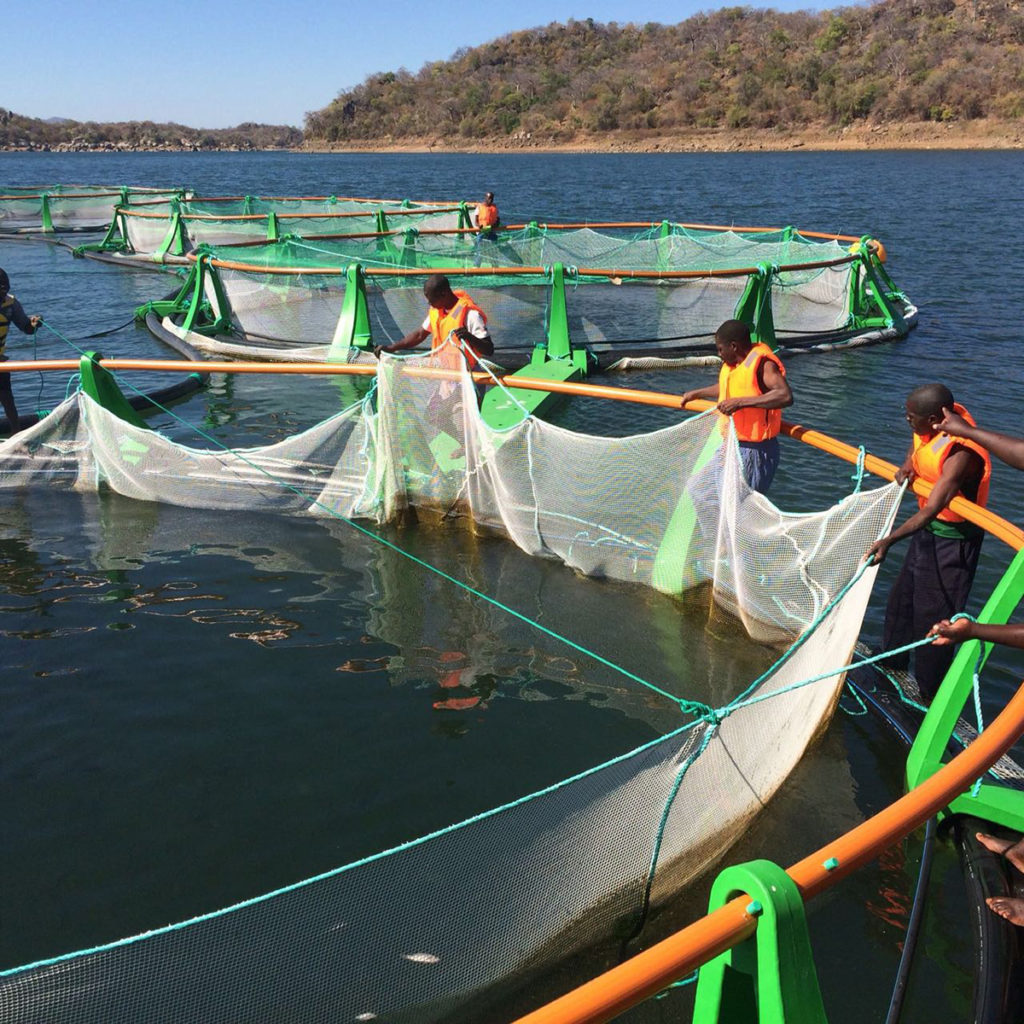
Responsibility
‘Model’ tilapia venture shows mettle in Mozambique
On the shores of Lake Cahora Bassa, Chicoa Fish Farm hopes to create a ripple effect to improve fish supply and quality of life for an impoverished region.
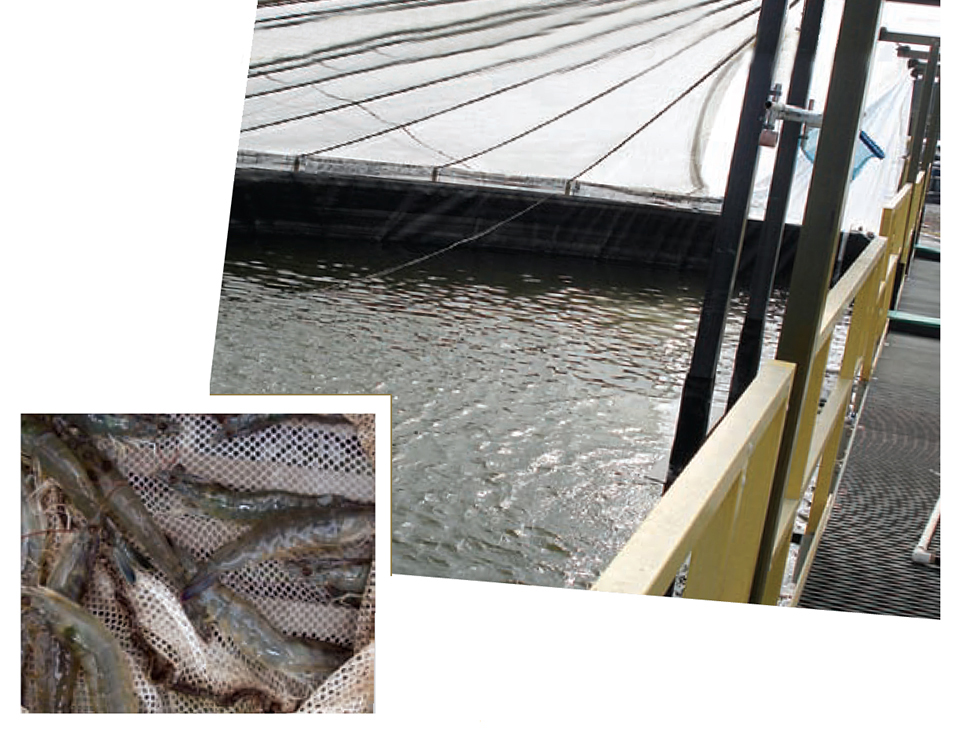
Health & Welfare
Commercial-scale RAS trial yields record shrimp production
A super-intensive, commercial-scale RAS trial with Pacific white shrimp at Oceanic Institute achieved record production at a low cost and with low stocking densities.


